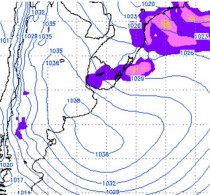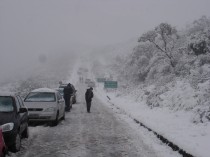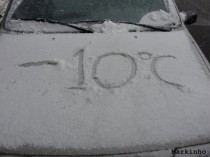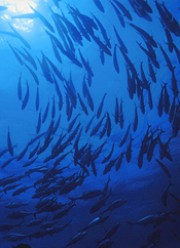Alexandre Aguiar, METSUL
Another Antarctic high pressure brought cold and heavy snow to Argentina and then southern Brazil.

This is a sampling from Santa Catarina, where it was the heaviest snow in over a decade:







See many, many more on the METSUL blog here.
i>By Rodrigo Orihuela
Argentina is importing record amounts of energy as the coldest winter in 40 years drives up demand and causes natural-gas shortages, prompting Dow Chemical Co. and steelmaker Siderar SAIC to scale back production.
Electricity supplied from Brazil and Paraguay rose to a daily combined record of about 1,000 megawatts on July 12, while consumption peaked at 20,396 megawatts three days later, according to Buenos Aires-based energy broker Cammesa. Shipments of liquefied natural gas are set to double this year.
Dow, Siderar and aluminum maker Aluar Aluminio Argentino SAIC are among companies closing plants, cutting output or seeking alternative energy sources after temperatures in parts of Argentina fell below those of Antarctica on July 15. Rising demand is exacerbating a shortage that began six years ago as economic growth accelerated and energy investment fell. The shortage is boosting costs as companies spend more to guarantee supplies.
“The situation is getting worse, because the shortage period is growing every year,” Gerardo Rabinovich, a director at the General Mosconi Energy Institute in Buenos Aires and an adviser to the opposition Radical Party, said in a telephone interview. “When this started in 2004, it lasted for about a week, then it was two weeks and now it’s more than a month.”
In July, temperatures in Buenos Aires were, on average, 1 degree Celsius below the usual low and high of 8 and 14 degrees (46 and 57 degrees Farenheit), with temperatures plummeting to about 2 degrees Celsius on July 15.
Renewed Cold
Also on July 15, temperatures in Mendoza, the wine- producing region in western Argentina, fell as low as -8.9 degrees Celsius below the temperature registered that day in the Argentine-controlled area of the South Pole, according to a national weather institute report.
Argentina is bracing for a renewed polar front this month. On Aug. 1, almost half of the country’s 23 provinces registered temperatures below zero, while the northern city of La Quiaca on the border with Bolivia fell to minus 10 degrees Celsius (14 degrees Fahrenheit.) The average low predicated through Aug. 5 is 1 degree, according to the National Weather service.
Dow closed a polyethylene plant in July and reduced operations at another facility to minimum capacity after gas supplies were rationed by the government, said Soledad Echague, a spokeswoman for the Midland, Michigan-based company in Buenos Aires. The cuts were more severe than the company had expected, she said.
Power Purchases
“The situation should be under control, as long as the weather improves,” Horacio Mizrahi, a spokesman at Argentina’s Planning Ministry, which oversees the country’s energy policy, said in a July 27 telephone interview from Buenos Aires.
Aluar needs a constant supply of electricity at its 410,000 ton-per-year aluminum smelter in Argentina’s southern Chubut province. The company is buying power to keep the plant running during peak gas consumption hours this winter, a spokesman for the Buenos Aires-based company, who declined to be named under company policy, said in a July 26 telephone interview.
Siderar reduced production to a minimum during peak gas consumption hours in July, according to a company spokesman, who declined to be named, citing company policy.
Argentina has doubled purchases of LNG shipments to 14 this year to address the shortages. Each shipment equals 3 million British thermal units of the fuel. Seven ships were bought last year, according to government data compiled by the Argentine Oil and Gas Institute, an industry research group.
Reduced Supplies
About 300 hundred industrial users have faced reduced power supplies since yesterday, according to reports in local media, including newspaper Clarin, Argentina’s biggest newspaper, and television channel C5N. The cuts started after residential gas consumption rose 42 percent yesterday to 85 million cubic meters (3 billion cubic feet) from 60 million, Clarin reported today.
July and August are Argentina’s coldest months. The winter months have put stress on energy supplies since 2004, when economic growth of an average of 8.5 percent a year stoked demand and price caps on gas, oil and utility prices curtailed investments in the country’s fields and pipelines.
The energy shortages led to restrictions of exports to Chile, which obtained about 80 percent of its natural gas supplies from Argentina until 2009, when it opened the first of two LNG plants. A gas pipeline that links the two countries across the Andes mountains is now practically unused after Argentina curtailed exports to its Latin American neighbor.
Spot Cargo Purchases
Aside from the 14 ships bought through a bidding round earlier this year, Argentine state-owned energy company Enarsa bought at least one spot cargo of LNG this year from Ras Laffan Liquified Natural Gas Co., according to the Qatari company. Enarsa’s head of communications Carlos Davidson did not respond to emails to his office and a phone call seeking comment.
Argentina needs an extra 40 million cubic meters of natural gas to cover the shortages, according to the Mosconi Institute’s Rabinovich. The country uses about 120 million in winter, he said.
Argentina’s Energy Secretary this year hired YPF, a unit of Spain’s Repsol YPF SA, to install a second regasification ship, which will be located on the Parana river off the city of Escobar, in central Buenos Aires province.
The new ship will be located within a radius of less than 200 kilometers from steel plants operated by the Techint Group and Arcelor Mittal’s Argentine unit Acindar. Argentine grain and bean producers and exporters, such as Bunge Ltd. and Cargill Inc., the country’s two biggest exporters in 2009, also have operations in the region. See story here.
By Carl Zimmer, Energy Bulletin
As warming intensifies, scientists warn, the oxygen content of oceans across the planet could be more and more diminished, with serious consequences for the future of fish and other sea life.
The Deepwater Horizon oil spill is overshadowing another catastrophe that’ also unfolding in the Gulf of Mexico this summer: The oxygen dissolved in the Gulf waters is disappearing. In some places, the oxygen is getting so scarce that fish and other animals cannot survive. They can either leave the oxygen-free waters or die. The Louisiana Universities Marine Consortium reported this week that this year’s so-called “dead zone” covers 7,722 square miles.
Unlike the Deepwater Horizon disaster, this summer’s dead zone is not a new phenomenon in the Gulf. It first appeared in the 1970s, and each summer it has returned, growing bigger as the years have passed. Its expansion reflects the rising level of fertilizers that farmers in the U.S. Midwest have spread across their fields. Rain carries much of that fertilizer into the Mississippi River, which then delivers it to the sea. Once the fertilizer reaches the Gulf, it spurs algae to grow, providing a feast for bacteria, which grow so fast they use up all the oxygen in their neighborhood. The same phenomenon is repeating itself along many coastlines around the world. This summer, a 377,000-square-kilometer (145,000-square-mile) dead zone appeared in the Baltic Sea. In 2008, scientists reported that new dead zones have been popping up at an alarming rate for the past 50 years. There are now more than 400 coastal dead zones around the world.
As serious as these dead zones are, however, they may be just a foreshadowing of a much more severe crisis to come. Agricultural runoff can only strip oxygen from the ocean around the mouths of fertilizer-rich rivers. But global warming has the potential to reduce the ocean’ oxygen content across the entire planet. Combined with acidification - another global impact of our carbon emissions - the loss of oxygen could have a major impact on marine life.
Scientists point to two reasons to expect a worldwide drop in ocean oxygen. One is the simple fact that as water gets warmer, it can hold less dissolved oxygen. The other reason is subtler. The entire ocean gets its oxygen from the surface - either from the atmosphere, or from photosynthesizing algae floating at the top of the sea. The oxygen then spreads to the deep ocean as the surface waters slowly sink.
Global warming is expected to reduce the mixing of the ocean by making surface seawater lighter. That’s because in a warmer world we can expect more rainfall and more melting of glaciers, icebergs, and ice sheets. Since freshwater is less dense than salt water, the water at the ocean’s surface will become lighter. The extra heat from the warming atmosphere will also make surface waters expand - and thus make them lighter still. The light surface water will be less likely to sink - and thus the deep ocean will get less oxygen. Instead, more of the oxygen will linger near the surface, where it will be used up by oxygen-breathing organisms.
The prospect that global warming could reduce the ocean’s oxygen has led some scientists to wonder if the predicted decline has already begun. It’s a maddeningly hard thing to determine, however. We can be very confident that humans have driven up the concentration of carbon dioxide in the atmosphere because scientists have recorded a steady increase over the course of decades. The signal of human-produced carbon dioxide is stronger than the noise of nature’s ups and downs.

Scientists predict declining oxygen levels could have a major effect on marine life. Photo credit: Veer Fluctuations in oxygen levels, on the other hand, are a lot noisier. As ocean currents oscillate naturally, upwellings of deep-ocean water can deliver nutrients to coastal waters, triggering an explosion of growth and driving down oxygen levels. Volcanoes can alter oxygen levels, too, by creating a haze that blocks sunlight, thus temporarily cooling the ocean’s surface and allowing more oxygen to dissolve into the water.
In recent years some worrying signals have started to emerge from the noise. In 2006, for example, oxygen levels off the coast of Oregon dropped to record lows. Reefs that had been packed with rockfish and other animals suddenly became ecological ghost towns. Instead of agricultural run-off, studies on the Oregon dead zone suggest that global warming was partly responsible. Higher temperatures have reduced the oxygen in the ocean currents that deliver water to the Oregon coast.
It’s much harder for scientists to figure out what’s happening in the open ocean than along the coastlines, because the records are far spottier. But some recent studies have also offered cause for worry. In April, for example, Lothar Stramma of the University of Kiel and his colleagues published a study in Deep Sea Research in which they compared records of oxygen levels in the tropical ocean from two periods: from 1960 to 1974 and from 1990 to 2008. In some regions, the oxygen levels have gone up, the scientists found, but in most places they’ve gone down. In fact, the area of the global ocean without enough oxygen for animals to survive (less than 70 micromoles per kilogram to be exact) expanded by 4.5 million square kilometers (1.7 million square miles). That’s an area about half the size of the United States.
Because the records of oxygen levels in the past are so incomplete, many scientists are calling for a push for more research. An international collaboration started in 1995, the Climate Variability and Predictability Repeat Hydrography Program - CLIVAR for short - is beginning to gather better data. 15 years to get rolling? But in the latest issue of Annual Review of Marine Science , Ralph Keeling of Scripps Institution of Oceanography and his colleagues warn that the CLIVAR program may need 20 to 30 years to establish long-term trends of oxygen levels. To speed up the process, they call for a global network of floating sensors known as Argo to be brought into the effort. If scientists put oxygen sensors on a few hundred of the 3,000 Argo floats, Keeling and his colleagues predict that a clear pattern would emerge in as little as five years. Keeling and his colleagues believe that it’s urgent to speed up this research, because the deoxygenation of the oceans could have a major impact on marine life.
In order to project how global warming will alter oxygen in the oceans, climate scientists are developing a new generation of computer models. The models are still too crude to capture some important features of the real world, such as the way winds can change how deep water rises in upwellings. But the models are good enough to replicate some of the changes in oxygen levels that have already been recorded. And they all predict that the oxygen in the world’s oceans will drop; depending on the model, the next century will see a drop of between 1 and 7 percent.
That could be enough to have a profound effect on life in the ocean, according to Daniel Pauly, a fisheries biologist at the University of British Columbia. In his new book, Gasping Fish and Panting Squids: Oxygen, Temperature and the Growth of Water-Breathing Animals, Pauly argues that getting oxygen is the most important constraint on the growth of fishes and many other marine animals. That’s because it takes a lot of energy to extract oxygen from water, and the bigger animals get, the more energy they have to invest.
Pauly and his colleagues are working on computer models to project how global warming will affect the world’s fisheriesGot to make use of those expensive supercomputers. Many species of fishes will shift their ranges away from water that’s too warm for them. But this flight from heat may force them into regions of the ocean with low levels of oxygen, where their growth will be limited. Pauly and his colleagues predict that the drop in the ocean’s oxygen and pH levels will together reduce the world’ s fish catch by 20 to 30 percent by 2050.
While fishes and other animals with high oxygen demands suffer, jellyfish may thrive. Jellyfish can tolerate lower oxygen levels than fish, in part because they can store reserves of the gas in their jelly. Free from competition and predators, jellyfish will be able to feast on the microscopic animals and protozoans that feed on algae. They may thus leave more food for bacteria, spurring a further drop in oxygen levels.
A drop in oxygen may also cause the ocean’s bacteria to change. Bacteria that need oxygen will no longer be able to thrive in oxygen-free zones of the ocean. But these dead zones will foster the growth of many species of bacteria for whom oxygen is toxic. Some of these oxygen-hating microbes produce nitrogen compounds that are among the most potent greenhouse gases ever measured. In other words, a drop in oxygen levels could further intensify global warming.
Unless we find a way to rein in our carbon emissions very soon, a low-oxygen ocean may become an inescapable feature of our planet. A team of Danish researchers published a particularly sobering study last year. They wondered how long oxygen levels would drop if we could somehow reduce our carbon dioxide emissions to zero by 2100. They determined that over the next few thousand years oxygen levels would continue to fall, until they declined by 30 percent. The oxygen would slowly return to the oceans, but even 100,000 years from now they will not have fully recovered. If they’re right, fish will be gasping and squid will be panting for a long time to come.
Carl Zimmer writes about science for The New York Times (why am I not surprised)and a number of magazines H/T Marc Morano Climate Depot
See the real story here.


